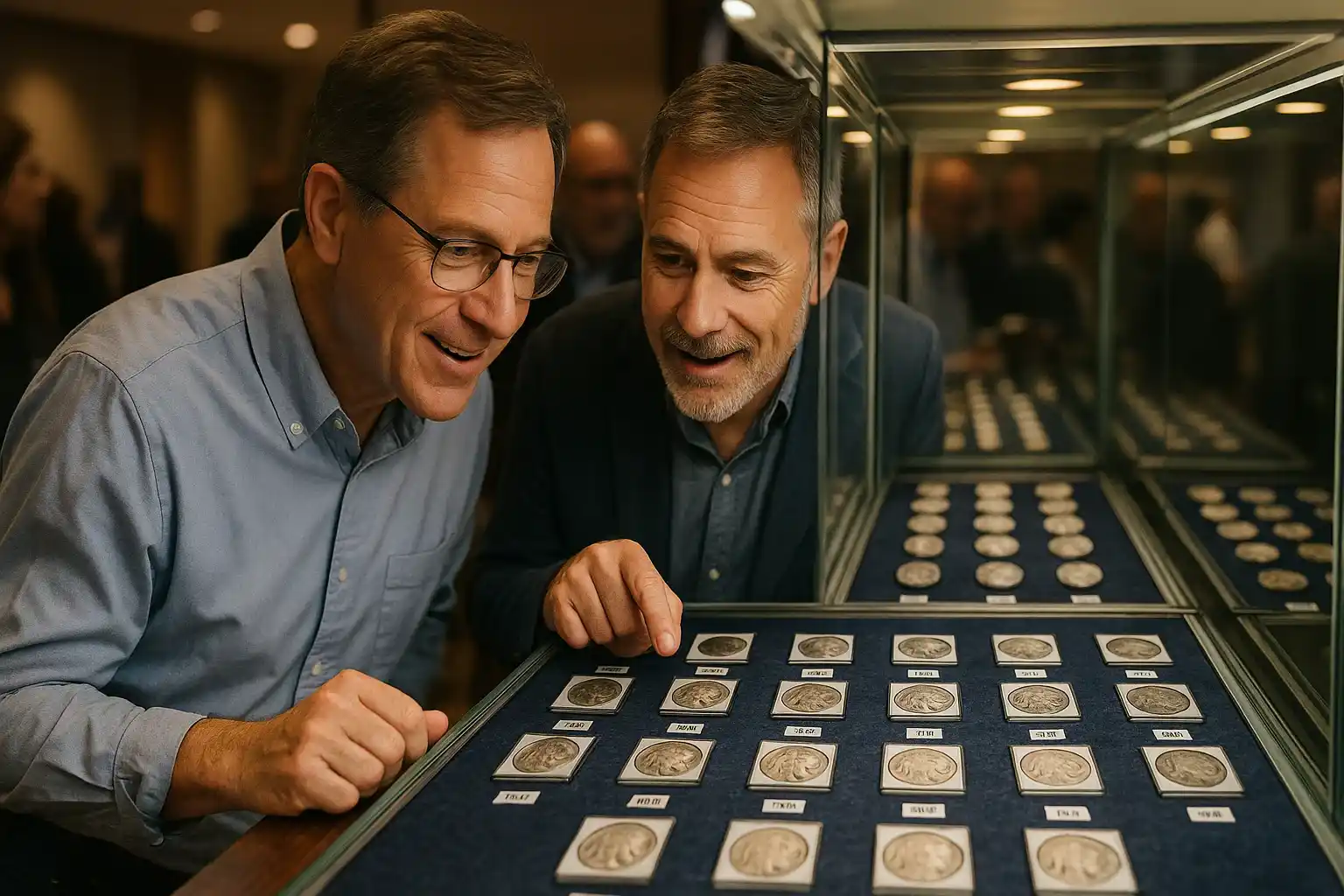Beyond Face Value: How Buffalo Nickels Became Investment Coins
How much is a buffalo nickel worth? The answer is never simple. On the surface, it was just a five-cent coin, used to buy candy, newspapers, or a streetcar ticket in the early 20th century. But in the world of numismatics, Buffalo nickels have taken on a much bigger role. They are not just old change from a bygone era — they are pieces of American history and,in some cases, even investment coins. So, we are going to explore how the Buffalo nickel transformed from everyday pocket change into a collectible with serious financial value.
Birth of the Buffalo Nickel (1913–1938)
The Buffalo nickel, officially known as the Indian Head nickel, was born out of a desire for something bold and American. By 1913, the U.S. Mint wanted to replace the Liberty Head design, which many considered too plain. The task fell to sculptor James Earle Fraser, who prepared the coin's design that resonated with people at the time.
Obverse: Fraser designed a Native American portrait, said to be a composite of several chiefs — Iron Tail (Lakota), Two Moons (Cheyenne), and possibly John Big Tree (Seneca). The face is rugged, dignified, and unmistakably American.
Reverse: On the back, a massive American bison stands proudly. Most historians believe Fraser modeled it after Black Diamond, a buffalo from New York’s Central Park Zoo.
The design was powerful, but it also created problems: the raised mound on the reverse and the high relief on the obverse caused the date and denomination to wear down quickly in circulation.
Everyday Coin, Future Jewel
At first, Buffalo nickels were just money. They were used in groceries, for buying tickets, and filling cash registers across the country. But their striking design made them stand out, and even ordinary people sometimes saved them because they looked unusual compared to Liberty Head nickels.
The coin circulated heavily during the Great Depression and both World Wars, which means most of the surviving examples today are worn flat. That heavy use is the reason making well-preserved examples rare and valuable. What started as a common coin slowly evolved into a collectible treasure.

Varieties and Errors That Shaped Buffalo Nickel History
Some of the most exciting Buffalo nickels are rare dates and minting quirks and design changes that became legendary. Please refer below to see the main varieties and understand how small details can transform an ordinary nickel into a prized collectible.
Variety | Description | Market Impact |
1913 Type I | First-year design with bison on a raised mound; details wore down quickly. | Popular with collectors as the true start of the series, values rise in higher grades. |
1913 Type II | Modified design with flattened ground and larger denomination for durability. | More practical for circulation, scarcer in high grades, strong demand today. |
1916 Doubled Die Obverse | LIBERTY and the date show strong doubling, clear under magnification. High-grade coins are very scarce. | Premiums in the thousands, depending on grade. |
1918/7-D Overdate | A “7” lies beneath the “8” in the date, one of the most dramatic U.S. overdates. | Worn pieces fetch thousands, Mint State can hit six figures. |
1935 Doubled Die Reverse | Doubling visible on “FIVE CENTS” and “E PLURIBUS UNUM.” | Rare, often overlooked, brings solid premiums. |
1936 Doubled Die Obverse | Doubling on the date and LIBERTY, easier to spot in Mint State. | Collectible across grades, high demand. |
1937-D Three-Legged Buffalo | Die over-polishing erased part of the front leg. | Famous variety, reaches strong prices even in low grades. |
1938-D/S Overmintmark | An “S” faintly visible beneath the “D.” | One of the last oddities of the series, values stay high. |
Key Factors That Drive Value
So, what determines the value of a Buffalo nickel today? Several key factors come into play:
Date and Mint Mark
The year and the mint that produced a Buffalo nickel are often the first clues to its value. Philadelphia struck the largest numbers, while Denver and San Francisco made smaller outputs, so their coins are usually scarcer and more expensive in higher grades.
Condition
Grading shows how much detail the coin has kept over time. A heavily worn piece might bring only a small premium, but one in Mint State, with sharp lines on the portrait and bison, can be worth many times more.
Varieties and Errors
Special varieties and minting errors can push values even higher. Well-known doubled dies, overdates, and striking quirks such as the three-legged buffalo often sell for far more than regular issues of the same year.
Here is a table with key examples:
Example | Typical Circulated Value | Mint State Value | Special Notes |
1913 Type I (Philadelphia) | $15–$40 | $300+ | First year, mound reverse design |
1913-S Type II | $150–$400 | $20,000+ | Low mintage, key rarity |
1916 Doubled Die Obverse | $250–$600 | $10,000+ | Strong doubling, major variety |
1937-D Three-Legged | $500–$1,200 | $15,000+ | Famous error variety |
Common late 1930s (Philadelphia) | $1–$3 | $40–$75 | Readily available, high mintage |
Collector’s tip: If you can't accurately determine the value of your coin, don't worry — modern apps are here to help. For example, take the Coin ID Scanner app that lets you photograph a coin and quickly identify its year, mint mark, and approximate value range. It won’t replace professional grading, but it’s very useful when you’re sorting through coins at a shop or show.
Buffalo Nickels as Auction Highlights
Auction results often push prices far beyond typical catalog ranges. A few famous sales show how valuable certain Buffalo nickels can be:
1918/7-D Overdate – Heritage Auctions sold a Mint State 65 example for over $350,000.
1937-D Three-Legged – A high-grade coin brought $97,750 at Stack’s Bowers.
1913-S Type II – One of the rarest regular issues, selling for more than $100,000 in top grades.
Even common dates can surprise collectors. A late 1930s Philadelphia nickel worth only a few dollars in circulated condition might jump to hundreds if it is certified in Mint State 67.
The auction record books prove that Buffalo nickels are both historical relics and investment assets that attract serious bids.
Total Value Picture: What It Means Today
Bringing the data together, buffalo nickels offer several price tiers:
Common circulated coins: Usually $1–$5.
Better dates in decent grades: $50–$200.
Key rarities and error varieties: Thousands to six figures.
From pocket change to auction star, the spread is dramatic. For those considering value beyond collecting, the next question is whether buffalo nickels are worth investing in as long-term assets.

Investing in Buffalo Nickels: Opportunities and Pitfalls
Who the Strategies Suit (and Who They Don’t)
Good fit: Patient collectors or investors who enjoy U.S. history and can hold coins long-term.
Not ideal: Anyone chasing quick profits or unwilling to study mint marks and varieties.
Positive Scenarios
Buffalo nickels have moments when they shine far brighter than their five-cent face value. Take error varieties like the 1937-D Three-Legged Buffalo or the 1918/7-D Overdate: their market demand has stayed strong for decades, and prices often rise steadily.
High-grade coins (those that look almost new) also tend to appreciate, because supply is naturally limited — most nickels were heavily used in circulation. Another positive factor is nostalgia: this design has a cultural pull that keeps new collectors entering the market, which adds constant demand.
Negative Scenarios
Not every Buffalo nickel turns into a jewel. Millions were minted, and most common-date nickels in worn condition will never be worth more than a couple of dollars. Prices can also be volatile: during economic downturns, investors often sell collectibles first, which can drag values down. Another trap is overpaying for cleaned or damaged coins — they may look shiny, but their market value is often half of what an untouched example would bring.
FAQs: Collecting and Investing in Buffalo Nickels
Are Buffalo nickels still easy to find today?
Yes, circulated examples are common at coin shops and shows. Rare dates and error varieties, however, require careful searching or auctions.
Why do some Buffalo nickels sell for hundreds of thousands while others are only a few dollars?
It comes down to rarity, grade, and whether the coin carries a famous error or variety.
Are Buffalo nickels a good hedge investment like gold or silver?
Not really. They’re better viewed as numismatic collectibles with investment potential, rather than bullion-based hedges.
How do I know if I have a valuable Buffalo nickel?
Check the date, mint mark, and condition first. Then compare with auction results or catalogs. For tricky varieties, magnification or expert verification is key.
What’s the safest way to store Buffalo nickels?
Use protective holders or albums, avoid cleaning, and keep them away from humidity and sunlight to preserve value.
Looking at the Big Picture
Buffalo nickels are more than just old five-cent pieces. Thanks to the cultural resonance, striking design, and famous rarities these nickels have a dual role: as beloved collectibles and as investment coins that sometimes surprise with dramatic returns.
For most people, they’re best seen as a rewarding hobby with the bonus of real market value. Whether you hold a common date worth a few dollars or a legendary rarity worth a house, each Buffalo nickel carries a story — and that story is what keeps them alive in collections, auctions, and history books.

